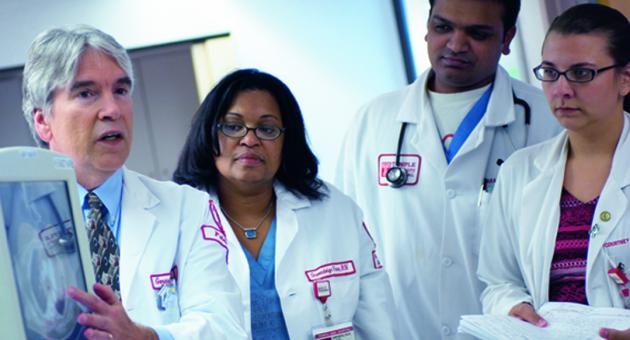Teaching the Health Sciences: patients, practice and professionalism

Health science students take on a unique set of responsibilities while preparing to enter their profession: They care for patients while still learning; they must pass licensing exams before beginning to practice; and they are required to exemplify professionalism. For these reasons and many more, teaching future healthcare practitioners demands a distinct set of skills.
Recognizing this need, three years ago Temple’s Teaching and Learning Center (TLC) created the Health Sciences Teaching Institute. Each year, faculty from the Schools of Medicine, Dentistry, Pharmacy, Podiatry and the College of Health Professions and Social Work gather at TLC’s Health Sciences Teaching Institute (HSTI) to tackle common issues and improve teaching to ultimately produce better health care professionals.
In developing the curriculum for the HSTI, TLC staff took time to observe health sciences teaching and talk with faculty. They found that what most sets health sciences teaching apart is that it often occurs outside the classroom, in clinics, hospital rooms and pharmacies.
“With clinical teaching, faculty take students on rotations with them,” said Pamela Barnett, associate vice provost and director of the TLC. “Together, they examine patients, diagnose medical conditions and create treatment plans.”
That unique dynamic requires that faculty possess the ability to practice and teach simultaneously, a prevailing theme for the HSTI.
“How do I balance the two? When do I step in if a student is struggling?” said Sally Gray, associate professor at the Kornberg School of Dentistry. “You have to continuously weigh how to best serve the patients and teach the students.”
Health sciences students are also expected to approach their work with compassion and provide their patients with a high standard of care. Exemplifying professionalism is a core competency for most health professions, yet it’s hard to define, teach and evaluate.
To clarify this aspect of the health sciences, the HSTI will focus on professionalism at its next session in February. Faculty will work together on how best to incorporate professionalism into the curriculum as well as how to assess it in their students.
HSTI participant Amy Heath, an assistant professor in the College of Health Professions and Social Work, believes that one of the best ways to teach professionalism to her students is to embody it herself.
“Modeling how to interact with patients and how to handle difficult situations can be very meaningful for our students,” said Heath.
Another challenge for health sciences instructors is the rigorous licensing exams doctors, dentists, nurses and pharmacists must pass upon graduation before they can practice. The looming exams can create a tension between teaching to the boards and teaching the practical side of medicine.
“What’s on the exams and what a student needs to be able to practice well in the real world doesn’t always match,” said Gray.
The value of the Teaching Institute, participants have found, is that they can work through these issues together, share experiences and bring suggestions back to their own classrooms.
“It’s very helpful to see what other faculty are doing,” said Ina Calligaro, associate dean of education at the School of Pharmacy. Calligaro and her colleagues have used the Institute to perfect their team teaching. Many health sciences courses are taught by a team of faculty members, each of whom brings his or her own expertise to the class.
“To make the courses work, the team really needs to collaborate and organize the material in a cohesive way,” said Calligaro. “We need to know what each person is covering and make sure students are getting the same message from all of the different faculty members.”
In its opening session last month, the institute focused on assessing deeper learning, a students’ ability to reason through material. With health professions, lives are at stake. Faculty need to know that students are learning and integrating the critical information they’ll need when taking care of patients in the real world.
Christina Rose, clinical assistant professor of pharmacy, took what’s proven to be an effective way to promote deeper learning from the HSTI into her classroom. In her clinical pharmacokinetics course, a large lecture class, Rose breaks the students into small groups to delve into complex questions.
“We’ve gotten good responses from students,” she said. “The questions help them discuss and work through concepts we have learned in class and they’re more prepared for tests.”
It’s a common concern for all health sciences faculty: how to help students learn at a deeper level so that they can think critically about patients and conditions.
“We have a very strong responsibility towards society when we educate our students,” said Calligaro. “Because lives are at stake, there’s a real ownership of student learning which is really heartfelt among the health sciences faculty.”